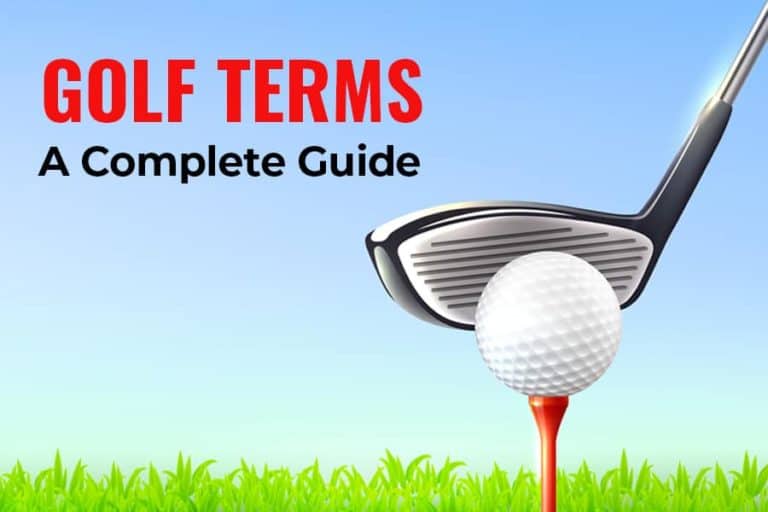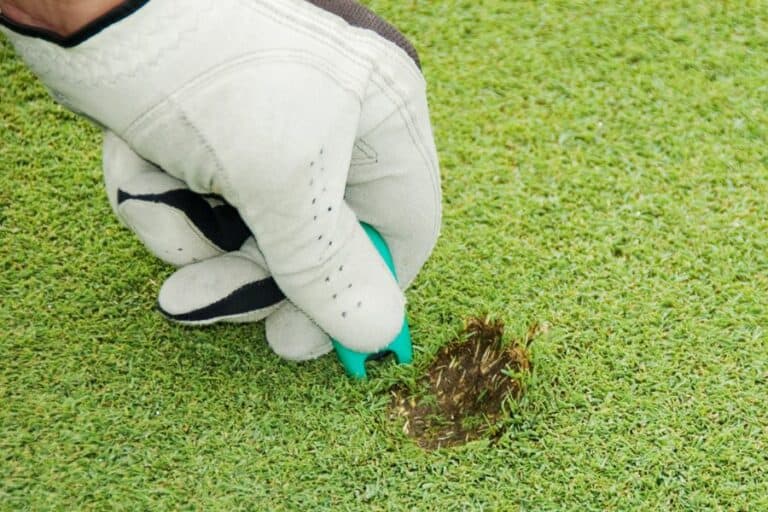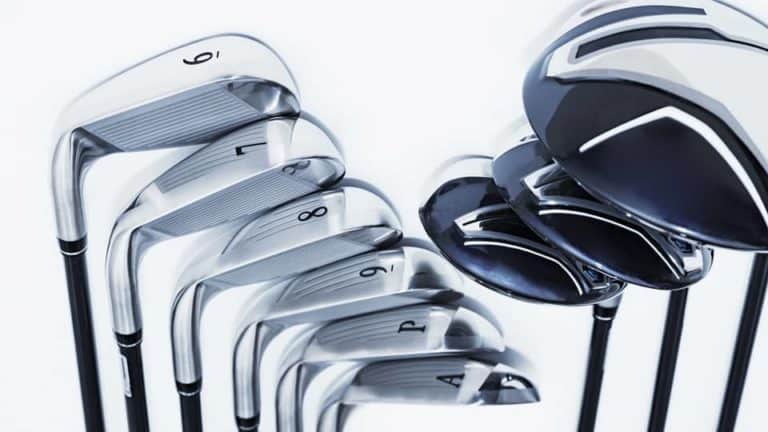How To Tell If Your Golf Clubs Are Too Long or Too Short?
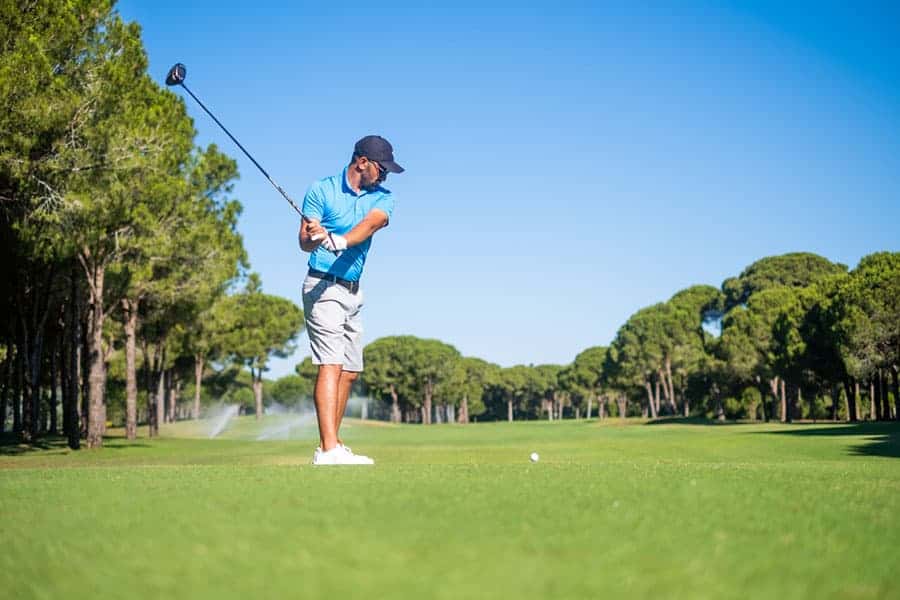
Wondering if your golf clubs are too long or too short? Here’s how to find out and what to do if they are.
Are you having trouble with your golf game? Are you consistently slicing the ball or not getting the club distance you expect? If so, it might be time to look at your golf clubs and ensure that the clubs are of the correct length for you.
Buying golf clubs straight off the rack and ending up with too long or too short golf clubs is one of the most common faults in club selection.
In this article, we will discuss how to tell if your golf clubs are too long or short and how to fix the problem. Keep reading for more information.
I. How to tell if your golf clubs are too long or short?
Many golfers think that having too long clubs won’t affect their performance, but they ultimately end up resulting in the most inconsistent shots.
On average, 90% of golfers look at the standard length golf club chart and end up getting clubs longer than they need.
Let’s get brief information about what signs indicate that your golf clubs are too long or too short. And what are the factors that affect the club lengths?
1. Signs Of Having Golf Clubs That Are Too Long
Golf clubs that are too long can cause inconsistent shots, heel and toe shots, and a tendency to pull the ball. A common problem with clubs that are too long is that they cause your back to assume too upright a position.
Below are the red flags that you can experience while playing with longer clubs:
Body Posture: If you need to stand up completely straight while holding the club, this is a sign that your clubs are most likely to be too long.
Swing Path: Even your clubs are too long if you can’t move your lower body while swinging the clubs.
Shots: If you find that trajectory of your shots are going to the right of your target or too high when you hit with the golf club, this is another sign that your clubs may be too long.
Shaft length: The clubs are too long if the shaft of the club feels heavy when it is held, gripped, swung, or even if you hit the ball with the club’s toe.
Divot: If the angle of attack is shallow and your divot is very small, then your golf club is too long.
2. Signs Of Having Golf Clubs That Are Too Short
Determine if your golf clubs are too short, based on the following ways:
You Are Hitting The Ground: If you find that you are hitting the ground more often than needed, your clubs are probably too short.
Bad body posture: If your posture is hunched over or stooped when you address the ball, your club length is too short.
Swinging The Club: If you find that you are swinging the club from the outside-in or the inside-out, your clubs may be too short.
Shots: If you find that your shots are going to the left of your target, this is another sign that your clubs may be too short.
How To Fix It: The best way to fix this problem is to have your clubs lengthened by a professional. However, there are a few factors you can consider to identify whether the club is of the ideal length for you like your height, the way to measure a club, and more.
II. Methods to determine the length of golf clubs
When you look at the pro golfers, many commonly use smaller clubs than the standard length clubs. Because this puts their spine in good posture to the ball, but this doesn’t mean that you need to get short clubs for yourself too. It depends on how long you need a club length according to your height, swing, and length from the wrist to the floor.
1. Overall Height
Your height plays a vital role in golf club length because it changes the angle of the club and how it makes contact with the ground as it strikes the ball flight.
The length of the golf club depends on the height and length of your arms. Because if you take a golf club with a shorter shaft, that will lead to improper body posture, and if the club is too long, you will get the shot nearer to you due to an improper swing path.
We have got you a height chart based on the standard length and our recommended length. But, Before you check out the height chart, you need to get the exact height measurement. So, follow the steps below to get an accurate height measure.
Steps to follow – How to measure your accurate height?
- First, you need to get someone who can help you get the exact measurement.
- Then stand with your back against the wall with your head straight.
- Let the other person grab a book or ruler and hold it on top of the head to mark a straight line on the wall where the book/ ruler meets the wall.
- Now move to a side. Measure from the line drawn on the wall to the floor with the help of a measuring tape. The measured length is your height.

Now that you know your height check out the chart for a better understanding.
| Your Height | Length Adjustment (From Standard) | Recommended Adjustment (From Standard) |
| 6’8″+ | Add 2 Inch | Add 1 Inch |
| 6’6″-6’8″ | Add 1.5 Inch | Add 0.5 Inches |
| 6’4″-6’6″ | Add 1 Inch | Standard |
| 6’2″-6’4″ | Add 0.5 Inch | Decrease 0.5 Inch |
| 6’1″-6’2″ | Add 0.25 Inch | Decrease 0.75 Inch |
| 5’7″-6’1″ | Standard | Decrease 1 Inch |
| 5’4″-5’7″ | Decrease 0.25 Inch | Decrease 1.25 Inch |
| 5’2″-5’4″ | Decrease 0.5 Inch | Decrease 1.5 Inch |
| 5’0″-5’2″ | Decrease 1 Inch | Decrease 2 Inch |
2. Wrist to floor Measurement (Static)
The distance between the wrist and the floor is a matter of concern. Because every person’s arm’s length and leg’s length is different, it is necessary to know the correct measurement.
Your club choice will need to be modified depending on how long your arms are. After all, long arms may affect the lie of your club. If your arms hang more, the toe of the club may be off the ground, which needs to be corrected.
Club fitters usually use this measurement to determine the perfect club length for golfers. Because even if two people are of the same height but still have wrist-to-floor measurements different due to their arm or leg lengths.
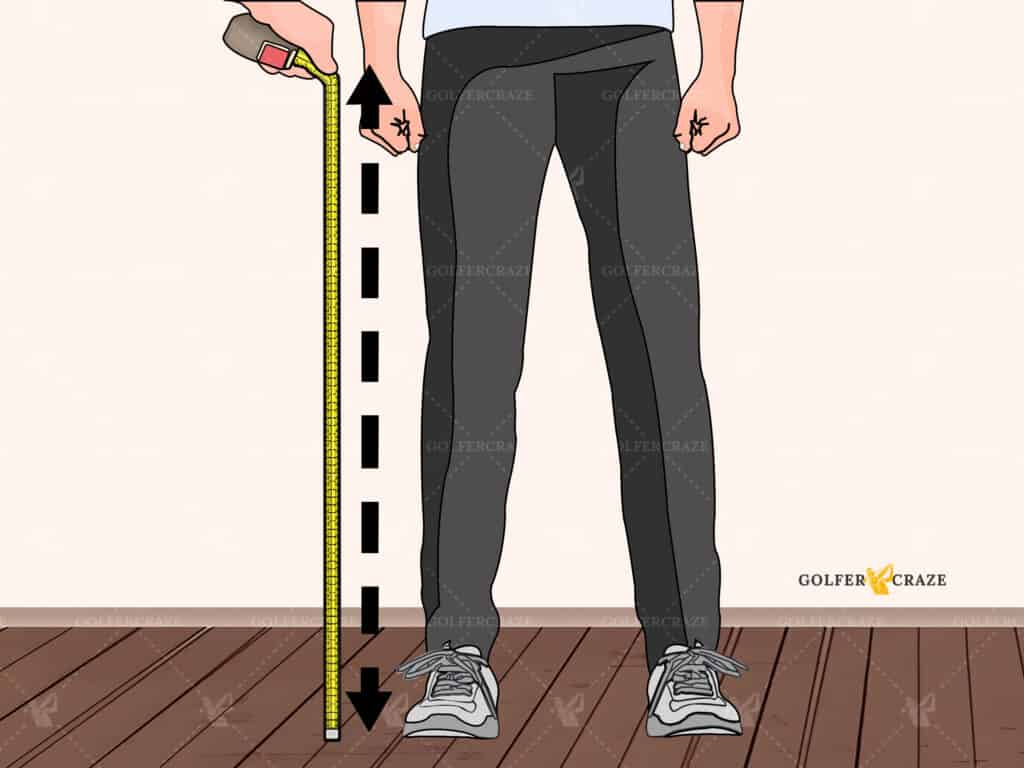
Therefore, follow these simple steps to get the exact measurement:
- Stand straight with your feet shoulder-wide apart so your feet are directly under your shoulders.
- Place the hands by your sides straight.
- Have someone help you get the measurement from the wrists to the floor using a measuring tape.
- Note down the measurement and use it while you purchase an exact length golf club.
Table representing wrist to floor measurement details:
| Height (feet/inches) | Wrist-to-Floor Measurement | Club Length Adjustment |
| 6’8″+ | > 42″ | Add 2″ |
| 6’6″-6’8″ | 41″ – 42″ | Add 1 1/2″ |
| 6’4″-6’6″ | 40″ – 41″ | Add 1″ |
| 6’2″ – 6’4″ – | 38.5″ – 40″ | Add 1/2″ |
| 6’1″ – 6″2″ | 37″ – 38.5″ | Add 1/4″ |
| 5’7″ – 6’1″ | 34″ – 37″ | Standard |
| 5’4″ – 5’7″ | 32″ – 34″ | Subtract 1/4″ |
| 5’2″ – 5’4″ | 29″ – 34″ | Subtract 1/2″ |
| 5’0″ – 5’2″ | 27″ – 29″ | Subtract 1″ |
| 4’10” – 5’0″ | 25″ – 27″ | Subtract 1 1/2″ |
| < 4’10” | < 25″ | Subtract 2″ |
3. Swing Path Considerations
The final way to figure out the correct length clubs is with the help of fitters because, in the other two methods, you were standing still, and these ways were static, which would help the professional golf club fitters incorporate an additional element into their club fitting sessions.
But, in dynamic club fitting, a player will be evaluated during the course by their actual golf swing speed, with measurements taken at impact and by the ball flight.
In this way, the club fitter not only determines the proper length but also observes the critical aspects that can help you improve your game.
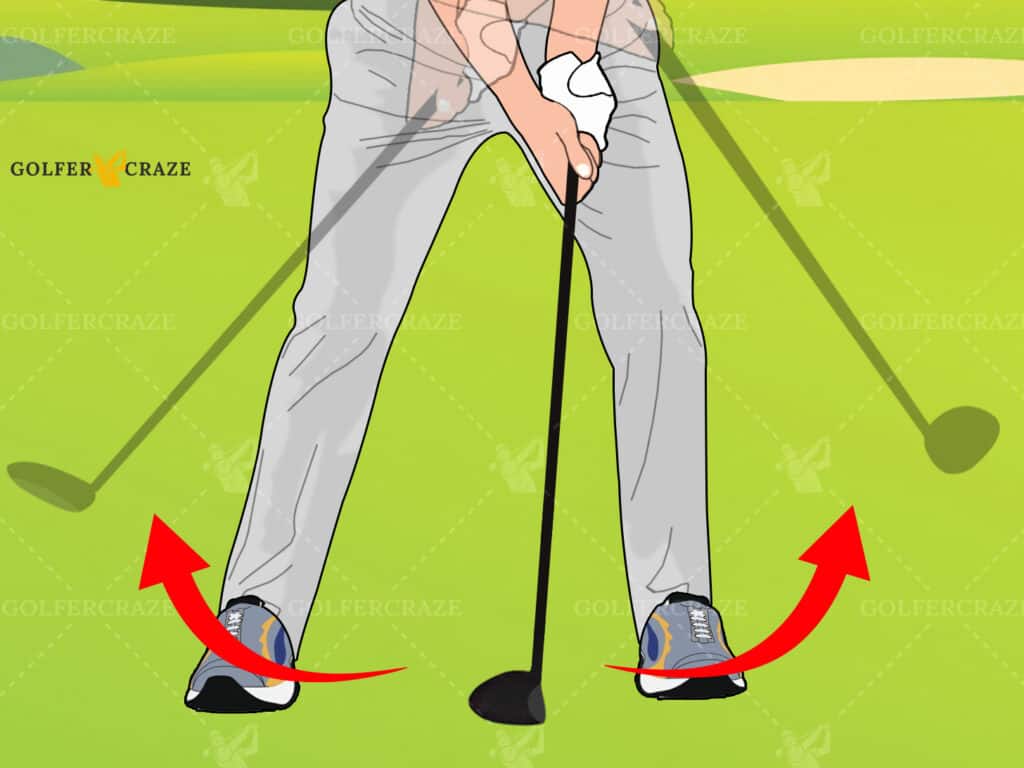
For example: While you are striking the ball, the club fitter can also help you by determining the tendency of the strike, whether it’s out towards the toe of the club face or in towards the heel of the club. So, if he feels that some modifications need to occur, he could suggest a flatter or more upright lie angle.
He can also evaluate the shaft flex and launch angle of your shots, which would ultimately result in recommendations for modifications in the club’s loft and a change in swing weight.
4. Measure How The Golf Club Sits On The Ground
The final step should be assessing the club’s position and making changes. This varies according to your measurement types, such as the putter iron or wood. So, read on further to know how to make the measurements for various kinds of clubs.
III. Adjustments based on the different types of golf clubs
The position and swing differ for different types of clubs such as wood, iron, and putters. Therefore, here are the adjustments required based on the clubs mentioned below:
1. Woods
Woods gives you greater swinging power and make it more powerful, which helps you have more stability. The balls are closer to your front foot and farther away. If you are using wood to see the correct length, you must position the ball in about that spot to verify your lie angle.
2. Irons
Iron is shorter than wood. And if you take iron, it generally rests in the center of the feet. Your body position is slightly twisted compared to a wooden club or shorter-sized clubs. This is the standard ball position for an iron.
It is essential not to be confused with the exact ball positions depending on which way the ball should be placed. It is also said that with higher numbers of irons, like eight irons and higher, you must hold the ball in the middle of the feet.
Whereas for 5 iron, 6 iron, and 7 iron, you need to place the ball one inch closer to the front foot from the center line between the feet and 2 inches for 4, 3 iron, and fairway woods.
3. Putters
The golf ball can have different positions on the putt. A good putt is when the player is in contact with the ball during the release of the putt. This happens if the putts are past your stroke mid-point and begin to rise.
The ball can therefore be placed an inch or two ahead of your foot’s centerline between your foot and your heel. But closer toward your front foot. It’s an easy and reliable way to position balls for measuring the size of putting terms. The grip on the putter varies depending on the length it should take.
These are some of the significant differences in the stances and how that affects your measurement of the length of the club you need to use.
IV. How much does it cost to adjust golf clubs?
Adjusting your golf clubs can help improve your game, but it’s important to know how much it will cost. The cost of adjusting your golf clubs can vary depending on the type of adjustment you need and where you go to have it done.
Here’s a split up of the average expected cost of shortening or lengthening your golf clubs:
V. How much does it cost to shorten golf clubs?
The cost of shortening your golf clubs is typically in the range of $3-5 per club. This doesn’t include a new grip. Again, if you prefer to keep your existing grips, you have to bear the extra “save grip” fee of approximately $10 each for those too.
VI. How much does it cost to lengthen golf clubs?
Extending the length of your golf clubs typically requires an investment of around $8-9 per club, not to mention a new grip.
If you’d like to spare yourself from paying for new grips, then you have the option to keep your old ones. However, this will come with an additional “save-grip” fee of about $10 per club.
Conclusion
In the end, If you’re experiencing any of these problems, it’s time to get fitted for new clubs. You can visit a local golf shop other than the methods mentioned earlier and get measured. The right clubs will help you improve your game and avoid fat shots.
FAQs
1. How do you know if golf clubs are too long?
It is common to find long clubs because their toes are off the ground, and they are usually in contact with their toes at addresses.
2. Does the length of a golf club matter?
The size of the golf club is crucial. Using proper-length golf clubs helps improve golf skills, but incorrect clubs are likely to do the opposite to them.
3. Is It Better to Buy A Golf Set Or Individual Clubs?
If we speak of a club set, it is quite a good start for beginners and amateur golfers, as it gives you an experience of using clubs and then helps them decide which golf club goes well, depending on the style and swing speed. Moreover, getting individual clubs depends on the skill level of the golfer.





